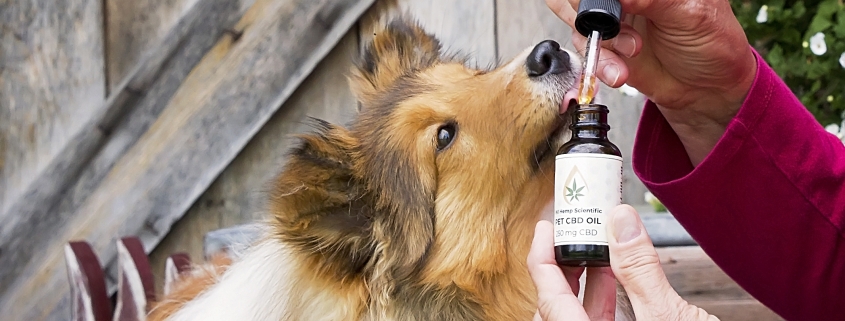BY EMILY HESSE, FREELANCER
It’s finally summertime in Wisconsin. Homeowners are busy cranking up the A/C and fulfilling plans to work in their gardens. Parents are running around trying to get their kids to summer camps, and families are loading up the old caravan to embark on their family vacations. But let’s not forget about our furry friends who are pawing at our doors, just begging to break free and go for their fifth walk of the day. That’s right, fifth. Well, so it seems. A great way to combat such anxiety and anticipation our dogs tend to exhibit in these moments is to let them sweat it out by exploring the great outdoors. We are all familiar with the phrase, “Want to go for a walk?” And certainly, we all know the spunky, head-tilting, perky-eared reaction that is sure to follow. But this summer, why not try saying something a little different? Here’s a new phrase: “Want to go for a… swim?” That one is sure to throw Fido for a loop. Nevertheless, your dog may be just as eager to splash through the water, as he or she is to walk down the neighborhood streets or run through the forest.
If the water life seems to float your dog’s boat, then you might want to take some time to check out a few of the beautiful lakes and rivers that Wisconsin has to offer. There are many parks in Southeastern Wisconsin alone that cater to the dog community. Some of these parks provide ample space for your pooch to roam the waterfront and dive into the cool, summer waters.
In order to research and experience the beauty of some of these doggy water parks, I took the opportunity to hop into my car and drive along with a friend and a four-legged companion to scope out potential hot spots. Though all it really took was a simple search on a map app to find some places, I went ahead and did the experiential research to find out for myself and report back. Among the many dog parks that are strewn throughout Southeastern Wisconsin, here are a few water-sourced ones to help your dog beat the heat this summer.
Lion’s Den Gorge Nature Preserve in Port Washington is a popular destination for humans and dogs alike. This place is not solely a dog park; however, dogs are very welcome and, in fact, encouraged to come and explore here alongside their human companions. Lion’s Den offers hiking, birdwatching, and fishing to the public, and it provides areas for folks to take a nice lunch break. Coursing throughout the 73-acre preserve are winding trails. These trails are kept nicely maintained for the public and are composed of mulch and gravel, which help absorb some of spring’s heavy rainfalls. There are several bridges along the way, which can make for fun photo opportunities. Not only do the trails take you twisting and turning among the trees, but they also lead to something even more spectacular. If you and your dog happen upon the right paths, you will be taken to either the bluff where you can overlook Lake Michigan or walk down to the lakefront.
The bluff is great for getting a grand, bird’s-eye view of the vast body of water and a strong breeze blowing through your hair. It provides the perfect backdrop to snap the selfie of your dreams of you and your pup. If you choose to go down to the lakefront, you will come across a wooden stairway that runs up and down the bluff to the refreshing water below. Although the stairway is steep, don’t worry; there are plenty of level spots along the way to rest. Upon reaching the bottom, you will be greeted by a long, sandy beach where the waves lap ashore. Sections of the beach have small rocks along the shoreline as well, which can help your pooch dry off a little before getting their wet feet too sandy to bring back into the car. This beachfront will give you all the space you need to play fetch with your dog as they challenge the waves of Lake Michigan.
Among the handful of beachgoers that day we visited, there were a few courageous pooches that dove into the water with full energy. One of them was a beautiful Australian Shepherd named Willow, who was eager to show-off her retrieving skills to nearby observers. Willow’s caretaker, Amanda Gonzalez, says she’s been coming there for a little over a year now. “This is definitely our favorite,” she quips. Gonzalez and Willow are among the regulars at Lion’s Den, but it’s not uncommon to meet people who check out the park from out of town and even out of state. One of the hikers that came down to the beach was Zach Rosenblatt with his handsome, brindle-colored dog Payton. Rosenblatt says, “This is the first time we’ve ever been here. We live in Chicago.” As Rosenblatt explained their origins, Payton proceeded to show me the ‘good boy’ he was by sitting and posing for the camera.
Many of the people who come to the trails to run or get in a good hike with their dogs find the water to be great for a post-workout cool down. Gonzalez went on to explain, “We usually run a bit first. [Willow] can then cool off in the waves at the beach. She requires a lot of exercise. Sometimes we bring a little lunch.” This special preserve of land has proven to be a gem in Southeastern Wisconsin. If you and your adventure buddy are looking to get out and explore an area with such biodiversity and natural beauty with plenty of places to rest, then give this park a good look this summer.
Lion’s Den is open to the public from 6 a.m. to 9 p.m. every day of the week, so there is plenty of time to enjoy the beauty that this park has to offer, and it is free-of-charge upon arrival. It also provides off-street parking—perfect for pulling up and letting your dog hop out of the car without fear of traffic from a busy highway. Like most public areas, it is required you keep your dogs on a leash and clean up after them. Bathrooms and disposal areas are available as well. Lion’s Den has received an average rating of 4.5 stars from different Google reviews, so the experience at this park is sure to keep those tails wagging.
Another park to keep on your radar this summer is Granville Dog Park located in the greater Milwaukee area. If you and Fido are looking to escape the city life but don’t want to travel too far outside of town, this park is a good place to start. Although this dog park is located practically in the city, it most certainly gives off rural vibes due to its 10 acres of trees, trails and river access. Keep a watchful eye because its entrance can be easy to miss but nevertheless, it is conveniently located right off Highway 45 and Good Hope Road. This section of land has quite a playful landscape for dogs, especially for the more athletically inclined and the true adventure seekers. It has hills, trees, shrubs, dirt paths and tall grass. But more importantly, the most prized piece of the land is, of course, the Menomonee River.
Upon walking into Granville Dog Park, everything seems to remain fairly quaint. To the left, there is a pathway that takes you up onto a steep hill where one can overlook the grassland and treetops for quite a distance. There’s even a bench provided. From the top of the hill, looping down, around and throughout the rest of the park are a bunch of little trails where your dog can roam free. Be careful as you walk around; some of the paths aren’t any bigger than an average-sized deer trail, and at this park, there are only dirt pathways. At the very least, this provides even more of a fun, off-roading adventure for your four-legged companion, right? To the left there is a beautiful, relaxing overlook, but to the right… That’s where the real adventure awaits. As you proceed down the path on the right, you may start to hear the commotion of happy dogs at play. Barking, splashing, humans yelling out directions to their K-9 counterparts and the flow of the river are all common sounds to be heard in Granville. At the riverfront, you may find the more active dogs chasing after toys their caretakers throw into the water for them or chasing after each other’s tails. You can also find older or smaller dogs basking in the cool river water or laying down under the shade of a big tree. Picnic tables are available to those who want to relax and enjoy their furry friends at play or sit down to a nice lunch in the shade.
Regardless of the inevitable water that is going to be splashed onto you and your clothing, this park has positive feedback. According to the online source, BringFido, “Granville Dog Park has received a rating of 4.8 out of 5 bones by 5 dog owners.” Granville Dog Park does not require dogs to be on a leash, even though a fence does not surround the whole property. Three sides of the property are fenced while the river acts as a fence on the fourth side. Also, proper dog licensing and permit tags must be available, including rabies vaccinations. Granville is open from 5 a.m. to 10 p.m. each day of the week. The park also offers disposal bins to get rid of any trash or waste that comes from your time spent here. Another bonus: This park is free of charge.
Our last and final stops on the doggy (water) park tour ends with a couple brief suggestions of excellent places where dog owners can get just as much joy out of the experience as do their four-legged friends. Estabrook Park Dog Exercise Area coincides with the Estabrook Beer garden in Shorewood. This makes it the perfect summer hangout for both dogs and humans. Running alongside the Estabrook Park is the Milwaukee River. This provides another opportunity for you to take a stroll alongside the river with your furry pal or to let him or her roam around in the off-leash and fenced-in area of the park, whilst you enjoy a nice brew. Permits, licensing and rabies vaccinations are required for this park, along with a daily or yearly pass in order to enter the dog park.
Lastly, Ridge Run Park, located in the heart of West Bend, provides winding trails through a wooded area and an ample body of water. As long as your dog is on a 6-foot leash, he or she can enjoy wading in the slow-moving water within this park. The park provides hikers with a segment of the Ice Age National Scenic Trail, so it’s sure to have scenic views. Within Ridge Run, there are many pavilions and shelters so you and your dog can take a rest or have a lunch break if desired. This park has no entry fee.
As animal lovers, not only do we want to live our best life for our families and ourselves, but we also seek to give our dogs the same kind of love and respect so they can live their best life, too. After all, dogs truly are man’s best friend, and they are just as much a part of our family as they ever could be.
So, before summer is over, take some time to not only plan out the big getaway vacations you want to take with your family and friends, but also spend some time traveling around with your pup to find his or her perfect getaway. Load up the car with some old towels, doggy bags, retrieving toys and some good tunes, and surprise your pup with the water park vacation getaway about which he or she has been having all those puppy dreams.







